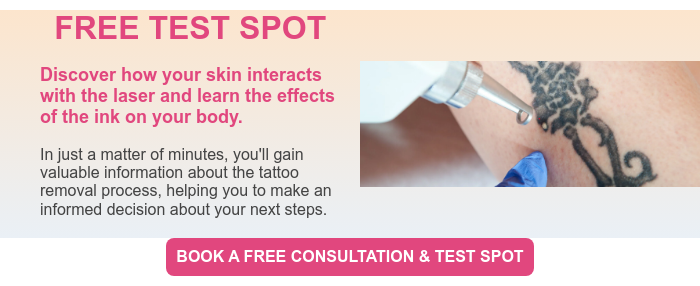 In our most recent post, we discussed what it’s like to be the expert Laser Tattoo Removal Boulder County, Colorado team, and we covered a lot of ground. In an article series intended to answer our customer’s frequently asked questions, we quickly realized it would take more than a single article.
In our most recent post, we discussed what it’s like to be the expert Laser Tattoo Removal Boulder County, Colorado team, and we covered a lot of ground. In an article series intended to answer our customer’s frequently asked questions, we quickly realized it would take more than a single article.
For our friends in Boulder County and nearby areas (we’re looking at you all in, Denver, Boulder, Louisville, Longmont, Broomfield, Erie, Lafayette!), we’ve compiled the queries that we hear the most, and we’re going to provide real, useful, straightforward answers.
We’d be happy to be selected as your tattoo removal service, but whether you choose us or someone else, we want you to know exactly what you’re getting into.
So, if you’re just stumbling into part two, we encourage you to check out part one, where we address these three frequently asked questions:
- What is the cost of laser tattoo removal?
- How many sessions will be required to remove my tattoo?
- Is the pain of tattoo removal significant?
Because tattoos represent such a personal choice it’s a big decision to decide to have one removed. In many cases, removal is an even more personal decision than the one that led to the tattoo in the first place.
Whatever is motivating you have your tattoo removed - a mistake based on impulse, a job-related choice, something deeply personal or a fading it in anticipation of a cover-up, we’re here to help.
So what other burning questions are our customers asking us? Let’s dive in and see.
A note on our FAQ series:
We’ve compiled these questions based on input from real patients, and we’re answering them based on our real experiences.
Whatever the reason – it’s ugly, it’s offensive, it’s unwanted, it’s a painful reminder – that you’re here asking about having a tattoo removed, the potential risks have got to be on your mind. When it comes to losing a tattoo, though, you’ve got two basic options: get it covered up with an even darker and more elaborate tattoo, or get it removed.
1. Will laser tattoo removal leave scarring?
Let’s start with the short and blunt answer: it is very unlikely but possible that some scarring could result.
Studies Show …
We use the latest most sophisticated, state-of-the-art equipment. And – as we go over in detail in Part One – we take every medically advisable precaution, including long waiting periods between sessions. We do that to allow the skin time to heal that minimizes the chance of adverse effects such as scarring.
Comprehensive studies have been done on our Cutera Enlighten III Pico / Nano laser technology. Finding that, correctly applied, removal of all colors, even dense black ink, reports no scarring, hypo- or hyperpigmentation, or textural changes in the skin of their subjects. However, industry-wide, something like 2% of patients report otherwise.
Is that because laser tattoo removal scars?
Not necessarily. There are possibly other factors are in play. What factors? It could be:
- Inefficient or outdated equipment being used by the tattoo removal expert.
- Technical error or poor technique.
- Not enough time between sessions.
- The patient could be picking at scabs or popping blisters between sessions.
- Scarring from tattoo procedure itself.
There’s a lot that you can do to minimize the risk of scarring, and we’ll work with you before your first session, and between every session, right through to the end, to make sure that you’re doing everything right.
Some tips:
- DO get lots of sleep, and drink lots of water. That helps keeps your skin healthy.
- DON’T smoke or drink excessively between treatments.
- AVOID tanning - unprotected sun exposure is bad for your skin, especially while healing from laser tattoo removal treatments.
- DO be careful about who you let use a laser on your body.
- DO ask your provider if they’re using the right equipment and methods for your particular skin type and tone.
Because each tattoo removal experience is different, you may be at particular risk if you have a history of scarring. But that doesn’t mean you shouldn’t try. We’ll monitor you between sessions, and check you carefully before and after every treatment. We know what it looks like if your skin isn’t handling the process well, and we can adjust our treatment as we go to further minimize your risks.
2. Can you help with tattoo cover-ups?
If you mean can we help fade a tattoo before a tattoo artist applies a cover-up, absolutely.
If you mean can we tattoo you? Not so much, but we can offer recommendations.
Covering a tattoo is a very particular art. There are artists that specialize in the process, and not every tattoo necessarily lends itself to being transformed or covered. When that happens, it’s only natural you might consider turning to us. Treating the skin with the laser during our state-of-the-art tattoo removal process will actually make your artist’s life easier when you go under the needle again.
The more dense and darker your tattoo is, the harder it will be to cover because the inked skin has been saturated with ink the leaving little room for more ink to be blended. Tattoos with lots of color or particularly bold line work are also difficult.
Speak to your tattoo artist either first, or in conjunction with the tattoo removal company you choose. That conversation will help set realistic goals of fading rather than removing a tattoo.
Once you and your artist have set expectations and made some plans, we’ll know which parts of your tattoo require our attention, and the best way to go about getting you ready for that perfect cover-up. When we’re done, they’ll find your skin will better accept defined line-work and color, the end result – a beautiful new tattoo.
Laser Tattoo Removal Helps the Cover-Up Process
3. What are the aftereffects of laser tattoo removal?
Discomfort – By far the most commonly cited concern, this one is pretty obvious. While getting a tattoo removed is uncomfortable, and some say it feels much like getting the tattoo itself, the removal process is super-fast, and the discomfort lasts a very short time. As we discuss in Part One, this depends on a lot of factors, including tattoo size, location, and how many treatments you need, but discomfort is a necessary part of the process.
- Frosting – This effect is an expected and safe reaction, although might be a surprise to many people. The skin being treated will turn a bright snowy white during the treatment. It comes from carbon dioxide being released from the skin as a chemical response to the laser breaking up the ink. It lasts no more than 10-15 minutes.
- Swelling, redness, pinpoint bleeding – A successful treatment will leave the treated area looking red, some moderate swelling and pin-point bruising is expected.
- Soreness – It’s common for the area to be tender after treatment. It may feel like sunburn. This is temporary, and easily dealt with by using a cold pack.
- Itchiness – Most people will feel an itching sensation as their skin heals and the ink is absorbed in the lymphatic system. As with any other irritant, scratching could break the skin and increase your risk of infection and possible scarring. Aquaphor® is a good choice as it protects, soothes and heals irritated skin. If the itching is too much to bear, you might try an over the counter topical antihistamine, and a cold, damp towel over the area to quell the itchiness. But, do not rub.
- Scabbing and blistering – Another necessary part of the healing process. Every patient will have some degree of blistering or scabbing during tattoo removal, and it’s manageable. Just don’t pick at them.
- Hyper/Hypopigmentation –During the removal process, different wavelengths of light are used to break up the ink in your skin. That can affect your body’s melanin, which gives your skin its color, or pigmentation. Hyperpigmentation is an area of darkened skin, and hypopigmentation is patches of lightened skin. When this occurs, it often completely resolves itself, but some patients never see the skin completely return to the same color. However, that’s often quite preferable to the tattoo itself.
- Infection – The risk of infection is relatively low. This is especially true if you follow our aftercare instructions. However, for those of you who can’t resist picking at scabs or popping blisters, the risk does exist, and so we feel it’s best to say so!
In future articles, we’ll address these questions and others more in greater detail, but for our friends in Boulder County and the rest of the Colorado area, we can’t emphasize this enough: knowledge is power, and we will always share our knowledge with you. Keep your questions coming. We welcome the opportunity to speak with you. Remember, our consultations are always free.
Thanks for reading!
 Google Reviews
Google Reviews




